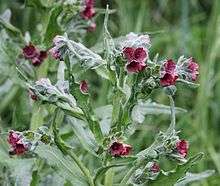Cynoglossum officinale
Cynoglossum officinale[1][2] (houndstongue, houndstooth, dog's tongue, gypsy flower, and rats and mice due to its smell) is a herbaceous plant of the family Boraginaceae,
| Cynoglossum officinale | |
|---|---|
 | |
| Scientific classification | |
| Kingdom: | Plantae |
| Clade: | Tracheophytes |
| Clade: | Angiosperms |
| Clade: | Eudicots |
| Clade: | Asterids |
| Order: | Boraginales |
| Family: | Boraginaceae |
| Genus: | Cynoglossum |
| Species: | C. officinale |
| Binomial name | |
| Cynoglossum officinale | |

Description
It can be either annual or biennial. Leaves are greyish and softly haired, lanceolate to oblong. Reddish-purple funnel-shaped flowers bloom between May and September.
Distribution and Habitat
Found in most parts of Europe, and also North America, where it was accidentally introduced.[3] It lives in wet places, sand dunes, waste land and hedges.
Ecology
Houndstongue may be pollinated by bees, and may also self-pollinate.
Etymology
The name houndstongue (and the latin genus Cynoglossum) comes from the roughness of the leaf.
Herbalism
In 1725, houndstooth was presented in the family dictionary, Dictionaire oeconomique, as part of a cure for madness.[4] In that book, madness was viewed as "a distemper, not only of the understanding, but also of the reason and memory, proceeding from a cold, which drys up everything it meets with that is humid in the brain."[4] To cure madness, Dictionaire oeconomique noted:
You must shave the head of the unhappy patient, and after that, apply to it a pidgeon, or a hen quite alive; or else bathe it with some brandy distilled with rosemary, elder, hounds tooth, and the roots of bugloss, or with the oyl of elder flowers: they rub their heads and wash their feet with a decoction of the flowers of camomile, melilot, balm gentle and laurel; they put into their noses the juice of comfrey, with either two or three spoonfuls of honey-water, broth, or white-wine, wherein wormwood and sage are infus'd ; or else they do for five and twenty days together, mix with their broth in the morning, halt a dram of the ashes of tortoise, and they put into the pot bugloss, borage, with a pinch of rosemary to season it.[4]
In the 1830s, houndstooth was known in France to be made into an emollient and diuretic for daily use in inflammatory diseases, especially of the urinary organs.[5] To prepare as a diuretic, the houndstooth leaves were mashed, and then boiled in water to extract oils, volatile organic compounds, and other chemical substances.[5] The mix could be sweetened with liquorice to create Ptisan of Dog's-grass.[5] After decoction, the herbal tea was taken internally a cupful at a time.[5] In 1834, the Hospital of Paris provided a formula of 2/3 ss—J to Oij of water for houndstooth tea.[5] By the end of the 1830s, doctors in England were using houndstooth as an antiaphrodisiac to combat venereal excesses.[6]
Herbalists use the plant for piles, lung diseases, persistent coughs, baldness, sores, and ulcers but the effectiveness of all these uses is not supported by any scientific evidence.[7]
As a weed
In 1891, the U.S. state of Michigan identified houndstooth, along with flea-bane, rag weed, burdock, cockle-bur, and stickseed, as some of the worst weeds in the state.[8]
Toxicity
Cynoglossum officinale contains tumorigenic pyrrolizidine alkaloids.[9] It is toxic to cows and is specially dangerous to pasture owners.[3]
Notes
- "Cynoglossum officinale". Integrated Taxonomic Information System.
- Cynoglossum officinale at USDA PLANTS Database
- "Invasive Species: Houndstongue". United States National Agricultural Library.
- Chomel, Noel; Richard Bradley (1725). Dictionaire oeconomique: or, The family dictionary. Printed for D. Midwinter. Retrieved October 8, 2011.
- Ryan, Michael (1835). "Collection of Formula of the Civil and Military Hospitals of France, Germany, Italy, Great Britain and Ireland". London Medical and Surgical Journal. 7: 527. OCLC 13350693. Retrieved October 8, 2011.
- Ryan, Michael (1839). Prostitution in London, with a comparative view of that of Paris and New York, with an account of the nature and treatment of the various diseases, caused by the abuses of the reproductive function. H. Bailliere. p. 385.
- Howard, Michael (1987). Traditional Folk Remedies. Century. p. 161.
- Seventh Annual Report of the Secretary of the Michigan Dairymen's Association. Michigan Dairymen's Association. Robert Smith & Co. 1891. p. 23.
- Fu, P.P., Yang, Y.C., Xia, Q., Chou, M.C., Cui, Y.Y., Lin G., "Pyrrolizidine alkaloids-tumorigenic components in Chinese herbal medicines and dietary supplements", Journal of Food and Drug Analysis, Vol. 10, No. 4, 2002, pp. 198-211
References
- Blanchan, Neltje (2002). Wild Flowers: An Aid to Knowledge of our Wild Flowers and their Insect Visitors. Project Gutenberg Literary Archive Foundation.
External links
| Wikispecies has information related to Cynoglossum officinale |
- Species Profile - Houndstongue (Cynoglossum officinale), National Invasive Species Information Center, United States National Agricultural Library. Lists general information and resources for Houndstongue.
| Wikimedia Commons has media related to Cynoglossum officinale. |